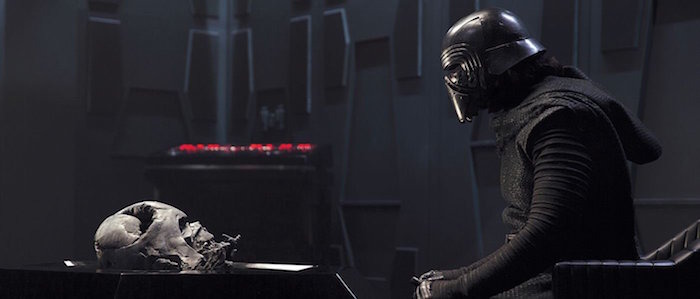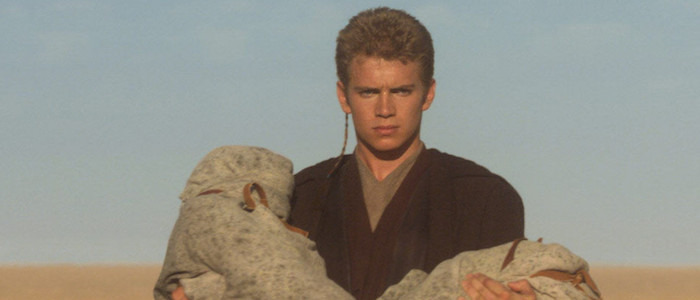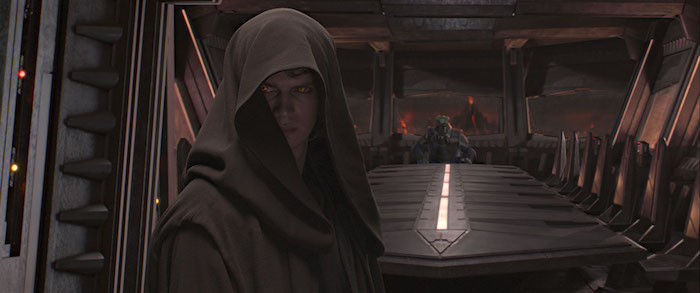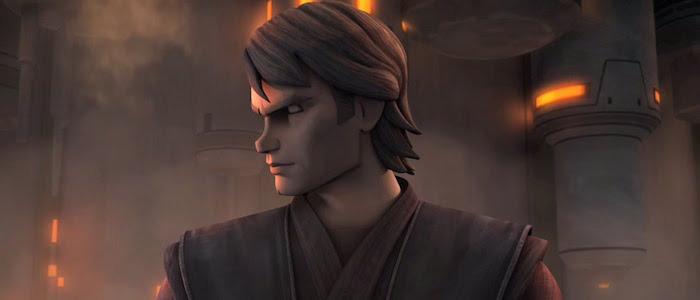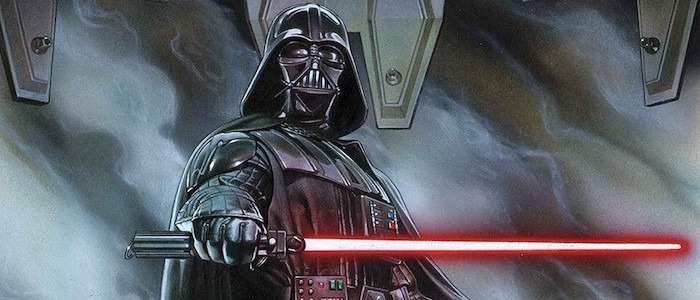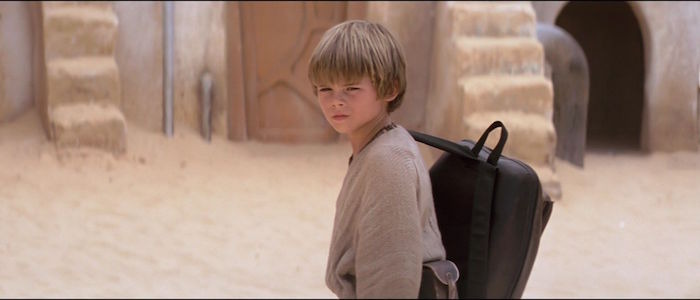In Defense Of Anakin Skywalker, The Most Unjustly Maligned 'Star Wars' Character
Even though Emo Kylo Ren is still making a mockery of the character on Twitter, Star Wars fans have actually begun to embrace the tortured, complicated character of Kylo Ren/Ben Solo as an antagonist to be reckoned with. Credit Rian Johnson and Adam Driver for taking the cartoonish Ren from The Force Awakens (remember Matt the Radar Technician?) and turning him into a more nuanced and more terrifyingly realistic villain. So, sure, I appreciate the way Johnson has rejuvenated the character, but is that reason enough to declare that Kylo Ren is an even better villain than Darth Vader himself? That Ben Solo's story is everything Anakin Skywalker's should have been?Being a constant presence in the Star Wars fandom is enough to give one whiplash; it sometimes feels like every debate is a competition between two extremes. Either the prequel trilogy is the film version of the antichrist, or it is an emblem of cinematic perfection. Either Rian Johnson ruined Star Wars, or he revitalized it. Either Kylo Ren is the greatest Star Wars villain, or Darth Vader is. How about this crazy, hot take: they're both pretty fantastic.
But I'd like to turn my attention to Darth Vader – or, more specifically, to Anakin Skywalker, the man within the machine – because there is so much more to the character than awkward Naboo picnics and diatribes about sand. And there are so many more Anakin Skywalker-centric stories to digest than the three prequel movies.
So join me, and together we will redeem the image of Anakin Skywalker.
Anakin vs. Ben vs. Vader vs. Kylo
It would be tempting to separate the man from the mask and proclaim that Darth Vader is a more iconic villain than Kylo Ren, while Ben Solo is a more compelling character than Anakin Skywalker. (Which is why The Last Jedi smartly shuns the Kylo Ren mask in order to dive deeper into Ben Solo.) An Empire article that puts Vader at the top of the list of the greatest movie villains of all time tries to do just that, insisting that Vader is an indelible part of pop culture history despite his much maligned backstory, not because of it.Yet without all of the Anakin Skywalker context, Vader really isn't much more than the Emperor's rabid attack dog, to borrow Princess Leia's phrasing from A New Hope. There is certainly something to be said for a villain that represents pure chaos, but a truly great villain – a character that goes beyond just character, one that also probes the darkest depths of humanity – is able to invoke empathy as well as revulsion and fear. (Think: Killmonger from Black Panther.) If we can understand where a character is coming from, if we can peek into their soul and witness the roiling mass of traumatic emotions and experiences, then we can begin to understand how a person might get to the breaking point – and, terrifyingly, how we might, too.
The Prequels
Allow me to channel Natalie Portman and say something nice about the muthafuckin' prequels.To begin with, I've never really understood what the big deal is with Jake Lloyd's performance as young Anakin in The Phantom Menace. That blonde little mophead was goddamn adorable. And a little bit irritating, sure, but have you met a nine-year-old who isn't? Plus, his interactions with Portman's Padmé Amidala seem weird in retrospect mostly because our brains are trying to grapple with the Hollywood Time Dilation Theory of aging, which states that female characters age much more slowly than male characters do – Anakin ages 10 years in between The Phantom Menace and Attack of the Clones (nine-year-old Jake Lloyd becomes 19-year-old Hayden Christensen), while Padmé ostensibly only ages two years (17-year-old Natalie Portman becomes 19-year-old Natalie Portman). Because of this, we tend to conflate Christensen's Anakin Skywalker with Lloyd's Anakin Skywalker, hence the accusation of "whininess" that plagues Christensen's representation as well as Lloyd's.And, yes: like that iconic Mean Girls character, Anakin Skywalker just has a lot of feelings. To be sure, his emotional outbursts in Attack of the Clones and Revenge of the Sith are incredibly difficult to watch. Most would say that the reason they're difficult to watch is because George Lucas is terrible at writing dialogue and Hayden Christensen is terrible at acting and the result is a cringetastic cheesefest that has been meme-ified a million times over.But I don't think that's entirely fair to Lucas' story or Christensen's acting. When it comes to what Anakin is actually saying, there is always a deeper meaning: his "I hate sand" speech is a veiled cry for help regarding his inability to overcome the trauma of his youth, while his fumbled confession of love for Padmé as they gaze into each other's eyes next to a crackling fireplace in a cozy, dimly lit room (I mean, seriously, girl? You're sending a pretty clear message there) is exactly what you'd expect from an emotionally stunted teenager.Viewed as part of the larger story of Anakin's life, his savagely violent outbursts carry weight as well. After unleashing his fury over his mother's death on the Tusken villagers, Anakin confesses to Padmé in an anguished whirlwind of misplaced rage, desperately attempting to justify his actions while knowing in his heart that they were wrong. Later, Anakin's terrified "what have I done?!" exclamation after aiding in the murder (or not) of Mace Windu reflects his belief that he has arrived at the point of no return – that whatever spark of good he may have fostered has suddenly been snuffed out. And his tortured scream of "I HATE YOU" after his battle with Obi-Wan... Well, I don't need to dig too deep for that one. Between those three words and Obi-Wan's tearful response ("You were my brother, Anakin! I loved you!"), there appears a boundless chasm of roiling, unspoken emotions. It breaks my heart every damn time.
There's a fine line between drama and melodrama – and sometimes, the tragedy of Anakin Skywalker leans a little bit too much towards melodrama. These emotion-fueled scenes make us uncomfortable, but I'd argue that it's because they feel so true – it's because they're so raw. After spending his childhood as a slave, Anakin is separated from his mother and the new father figure who promised to take care of him, and thrust into a life of stoic asceticism without ever learning how to manage his emotions. Which is how Anakin, the anointed "Chosen One," becomes the living embodiment of the failure of the Jedi Order.
A Victim of Toxic Masculinity
As the brilliant Pop Culture Detective explains in an incisive video essay, the philosophy of the Jedi Order dovetails with unhealthy cultural expectations about masculinity. Exhibit A: Anakin Skywalker.When young Anakin is tested for Force sensitivity in The Phantom Menace, he is called out in front of the entire Jedi Council for missing his mother. Yoda then tells this vulnerable nine-year-old in no uncertain terms that he (Anakin) is on the fast track to the Dark Side because of his (totally natural) fear of losing his mother: "Fear leads to anger, anger leads to hate, hate leads to suffering." Have you ever stopped to think about how royally messed up the sentiment behind this now iconic phrase is? Throughout his time in the Jedi Order, Anakin is told to bury his feelings, ignore his dreams, and most of all, to suppress his fear of loss – a feeling that, quite honestly, is central to the human experience.These encounters have a profoundly scarring effect on Anakin's psychological development. And when he does finally need to deal with his mother's death, he is emotionally unequipped to do so, since he has been told time and time again to disregard his feelings on the matter. Thus, the emotion that does break out is anger.In that video essay, Pop Culture Detective quotes intellectual theorist Bell Hooks, who writes:
"Anger often hides depression and profound sorrow. Depression often masks the inability to grieve. Males are not given the emotional space to grieve. They're still being taught to keep it in, and worse, to deny that they feel like crying. Unable to cope with the loss of emotional connection, boys internalize the pain and mask it with indifference or rage."
This rings true for Anakin, especially in all of the scenes described above. And if you're still unconvinced that the uncontrolled emotions of a young man in pain can lead to murder, just look the news headlines every single day. Star Wars is obviously a work of fiction, but it can still reveal and reflect on powerful emotional truths.It makes sense that Anakin finds a father figure in Palpatine after Qui-Gon dies and Obi-Wan doesn't offer himself up as an adequate replacement; though Anakin thinks of him in that way ("You're the closest thing I have to a father," Anakin tells Obi-Wan at the beginning of Attack of the Clones), Obi-Wan clearly views himself as more of a brother figure ("You were my brother, Anakin!" etc., sob sob sob). He's the ultimate bro, so to speak, and bros certainly don't sit down for honest chats about their feelings.All of this culminates with one of the most impactful moments in Revenge of the Sith, which is also a more downplayed display of emotion from Anakin. After assassinating the remaining Separatists on orders from Darth Sidious, Anakin – now officially christened Darth Vader – watches the boiling lava bubble up on Mustafar as a single tear rolls down his cheek. In this moment, Anakin's agony has calcified into pure rage, but that teardrop indicates that, as we know from Padmé and Luke, "there's still good in him." He may be a monster, but he is a monster who, at least, feels guilt.
The Clone Wars and Rebels
While the prequel saga traces Anakin's descent into darkness, the cartoon series The Clone Wars charts Anakin's meteoric rise in the time between Attack of the Clones and Revenge of the Sith. Now a Jedi Knight of his own, Anakin partners with his former Master, Obi-Wan, during the Clone War to fight on behalf of the Galactic Republic and against the secessionist Separatists. Anakin and Obi-Wan quickly become a legendary duo: Anakin as the Hero with No Fear (irony alert!) and Obi-Wan as the tireless Negotiator.The fact that Anakin is the implicit and explicit hero of the series presents an interesting dichotomy with the other Star Wars tales that frame him as the villain – or, at least, the anti-hero. True to the brilliance of executive producer Dave Filoni and the rest of the Lucasfilm creative group, the depiction of Anakin (voiced by Matt Lanter) in The Clone Wars feels true to the gestalt of the character while also making him more seem relatable. Anakin's interactions with his quippy padawan Ahsoka Tano show him to be a caring and engaged teacher, while his affectionate banter with Obi-Wan shows just how close the two became during the war. Even his relationship with Padmé feels less tacky when the two are presented in a simplified (albeit still secret) state of marital bliss.But there has to be a darker element to Anakin's relationships as well: Anakin's protectiveness towards Ahsoka turns into a deep mistrust of the Jedi Order when the Council eventually betrays her, and as close as Obi-Wan and Anakin are, we never see them discuss the war and their past traumas with any degree of seriousness. In the "Slaves of Zygerria" arc, Anakin simmers with barely contained anger in the presence of a group of slavers, but Obi-Wan doesn't actually confront him about it – he only asks Ahsoka, somewhat dismissively, to keep an eye on him. And of course, Anakin's relationship with Padmé takes an unhealthy turn whenever he feels that she is threatened, exhibiting Anakin's undeniable (though understandable, given the Jedi's backwards views on such things) chauvinistic streak.Interestingly, however, many of Anakin's arguments with Padmé and with his fellow Jedi Knights are presented as a clash of political ideals. If the prequels build up Anakin's emotional vulnerability, The Clone Wars series adds to this his sometimes unorthodox, sometimes naive views on war, cultural responsibility, and democracy – views that aren't always entirely wrong.Sure, we see Anakin attempt to mansplain the entire war to Ahsoka in "Heroes on Both Sides," telling her that it's "complicated" while then proceeding to paint both sides in black and white. (Ugh.) But we also see him suggest to Padmé in "The Zillo Beast Strikes Back" that in wartime, secrets should remain secret for the people's own good. (Debatable.) We see him agree with the severe Captain Tarkin when the latter disapproves of "peacekeepers" leading the war effort; Anakin adds that the Jedi often fall short of victory because of their defense-first methods. (A fair point.) Finally, we see Anakin "brand [himself] a cold-blooded killer" when Death Watch sympathizer Tal Merrik threatens to blow up Duchess Satine Kryze's ship, and Anakin is the one to take action while the Duchess and Obi-Wan deliberate. Considering the amount of lives at stake, it's certainly difficult to fault Anakin for that. All of Anakin's stories on the canceled-too-soon Clone Wars provide us with context for his eventual Fall while simultaneously building up his character as an understandably flawed human being.We are rarely more aware of Anakin's eventual descent to the Dark Side than during the Mortis storyline in season three, which distills Anakin's entire prequel trilogy tragedy arc into three 22-minute episodes. When a holy trinity of Force deities attempts to determine whether or not Anakin is indeed the Chosen One by compelling him to choose between saving Obi-Wan and saving Ahsoka, it successfully puts us in Anakin's headspace: he feels that he is constantly being made to choose between two impossible choices. And nothing puts me on Anakin's side more than the "Deception" arc, which saw the Jedi Council and Obi-Wan concoct a plan to fake Obi-Wan's death while keeping Anakin – yeah, the kid the Council frequently calls out for his fear of loss – in the dark! (Pun intended.) That betrayal, combined with the sting of Ahsoka leaving at the end of season five, paves the way for Anakin's Fall in a way that feels not only inevitable, but understandable. It becomes a matter not of "he had to Fall," but "no wonder he Fell."
Darth Vader Comics
When it comes to the story of Darth Vader, there are some huge gaps to fill between movies. So if you're only getting your Vader fix from the screen, you're missing out on the beautifully complex story being told on the (illustrated) page.Kieron Gillen's 25-issue Darth Vader series explores Vader's journey between A New Hope and The Empire Strikes Back as he grapples with the realization that the brazen Rebellion pilot who spearheaded the destruction of the Death Star is his son – another mark of betrayal from his old life as Anakin Skywalker. Taking place at the height of Darth Vader's reign of terror, Gillen's series lifts up the iconic mask to explore the trauma that haunts the galaxy's most fearsome villain. In Issue #24, Vader relives the moment his closest friend dismembered him and left him to burn, merging this memory with the more recent one of himself striking down old Ben Kenobi to at last exact his revenge.But these memories are tainted with another – a false memory, an image of a blue-eyed, blue blade-wielding Anakin Skywalker expressing grief over his old master's death, infusing Vader's cold rage with something that we may have thought had become anathema to him: guilt.The new ongoing Darth Vader series from Charles Soule fills in the blanks after the curtain falls on Episode III, depicting the near erasure of Anakin Skywalker as the specter of Darth Vader rises. The series begins by recontextualizing Vader's much-parodied "Noooo!" when he finds out about Padmé's death at the end of Revenge of the Sith. It is a reaction of pure anguish – but the pain is trapped inside, hidden by the unfeeling circuits of machinery.In each subsequent issue, conflict churns underneath that sleek, imperturbable mask; Vader is a monster, but he knows he's a monster. As Soule explains to StarWars.com, "at the beginning, he has to double down on his darkness as a 'coping mechanism.'" Vader takes no joy in his second life – it is an angry defiance that propels him, and a crushing despair that keeps him from going back. But the fact that he's aware of the wrongness of his villainous actions could make him more open to the redemption that will come in Return of the Jedi.In The Last Jedi, Rey reiterates her assessment of Kylo/Ben from The Force Awakens: "You are a monster," she declares. Ben – for this is definitely the child behind the mask – responds tonelessly: "Yes, I am." Meanwhile, well before The Last Jedi hit theaters, an arc in Soule's comic series traversed the same territory: Sent by Darth Sidious in the days after Revenge of the Sith to construct his new Sith lightsaber, Vader ends up dueling an exiled Jedi named Kirak Infil'a. After being handily defeated by Infil'a the first time, Vader returns with a vengeance, distracting Infil'a from their duel by using the Force to kill the guards protecting a city dam. After tossing around the word "monster" in their previous fight, Infil'a echoes himself and foreshadows Rey by once again telling Vader: "You're a monster." And Vader responds with the same chilling certainty as Kylo, speaking from behind his broken mask: "Yes. I am."
You either die a hero, or live long enough to become the villain
Anakin's mutation into a suit of mechanized armor is the perfect representation of his character's transformation; the boy who felt too much and felt too deeply becomes a machine that for so long perfected the art of feeling nothing at all. Adrift in a culture that taught him to bottle up his feelings, Anakin fell prey to the self-hatred that many young men in our day and age are lost to. Importantly, understanding Anakin's suffering is not the same as absolving him of his crimes, but it does shine a light on the ways that he was wronged as well. Like Black Panther's Killmonger, Anakin is correct in his assertions (the Jedi are corrupt) but wrong in his execution. That grain of truth is what will hopefully lead to a new and improved Jedi Order under the guidance of Rey.The tapestry of Darth Vader, one of the greatest and most tragic villains in pop culture history, is woven from more than just three movies: it is also comprised by three additional movies, two television series, several comic book series, and more. The blended image of Anakin Skywalker and Darth Vader represents both humanity's capacity for great evil as well as our capacity for redemption. He is at once an emblem of what it means to be human as well as a symbol of the way we humans can fail one another. Without Anakin's emotional struggles in the prequels, without his martial victories in The Clone Wars, and without Vader's invisible angst in the comics, he is just another bad guy in a mask. But with these stories, we can finally understand the pain and pathos of the broken boy within.

